There is something about impressionism that is peaceful, yet so chaotic all at once. Claude Monet happens to be one of my favorite painters, like so many others would claim. In this post, I am highlighting some of his most significant work and providing background information on famous Monet Paintings.
What you should know about Claude Monet himself
Claude Monet (1840–1926) was a French painter and a leading figure in the Impressionist movement. He is renowned for his innovative approach to painting. It is characterized by a focus on capturing the effects of light and atmosphere in his works.
Key points about Claude Monet:
Early Life:
- Monet was born on November 14, 1840, in Paris, France. He showed an early interest in art and began his formal training at the Le Havre secondary school of the arts.
- Monet moved to Paris in the early 1860s and became associated with a group of artists who would later form the Impressionist movement. The term “Impressionism” itself comes from one of his paintings, Impression, Sunrise.
Painting:
- Monet is known for his approach to oil painting and the profound impact that it had on modern art. While he explored many mediums, such as watercolor and gouache, oil was his chosen entity. He applied oil paints with loose and expressive brushstrokes, capturing the effects of light and atmosphere in his landscapes and scenes.
Giverny:
- In 1883, Monet moved to Giverny, a small village in the Normandy region of France. There, he created a stunning garden and a water lily pond, which became the subjects of many of his later works.
Later Years:
- His later works, particularly the large-scale Water Lilies series, are considered masterpieces.
- Monet developed cataracts, leading to a decline in his eyesight. Some have speculated about how this might have influenced the colors and techniques in his later works. It’s true that cataracts can affect one’s perception of colors. However, the extent to which Monet’s vision influenced his art remains a topic of discussion among art historians.
Legacy:
- Claude Monet’s impact on art history is profound. His innovative use of color and light influenced not only the Impressionist movement. Also, it influenced subsequent movements like Post-Impressionism and even abstraction. His commitment to capturing the essence of a scene rather than its precise details opened new possibilities for artistic expression.
- Claude Monet’s contributions to art and his revolutionary approach to painting have secured his place as one of the most influential figures in the history of Western art.
Monet’s use of Plein Air Painting
“Plein air” is a French term that translates to “open air” in English. In the context of art, it refers to the practice of creating artwork outdoors. Also, directly from the natural environment, rather than working in a studio from sketches or photographs. Artists working en plein air aim to capture the immediate effects of light, color, and atmosphere in the scenes they observe.
Monet would set up his easel and canvas outdoors to paint directly from the scene he was observing. This allowed him to capture the nuances of natural light and the changing atmosphere.
Monet’s plein air approach is evident in his series paintings. In this case, were he would paint the same subject at different times of the day or under various weather conditions. The Water Lilies series, Haystacks series, and Rouen Cathedral series are notable examples.
Impression, Sunrise (1872)
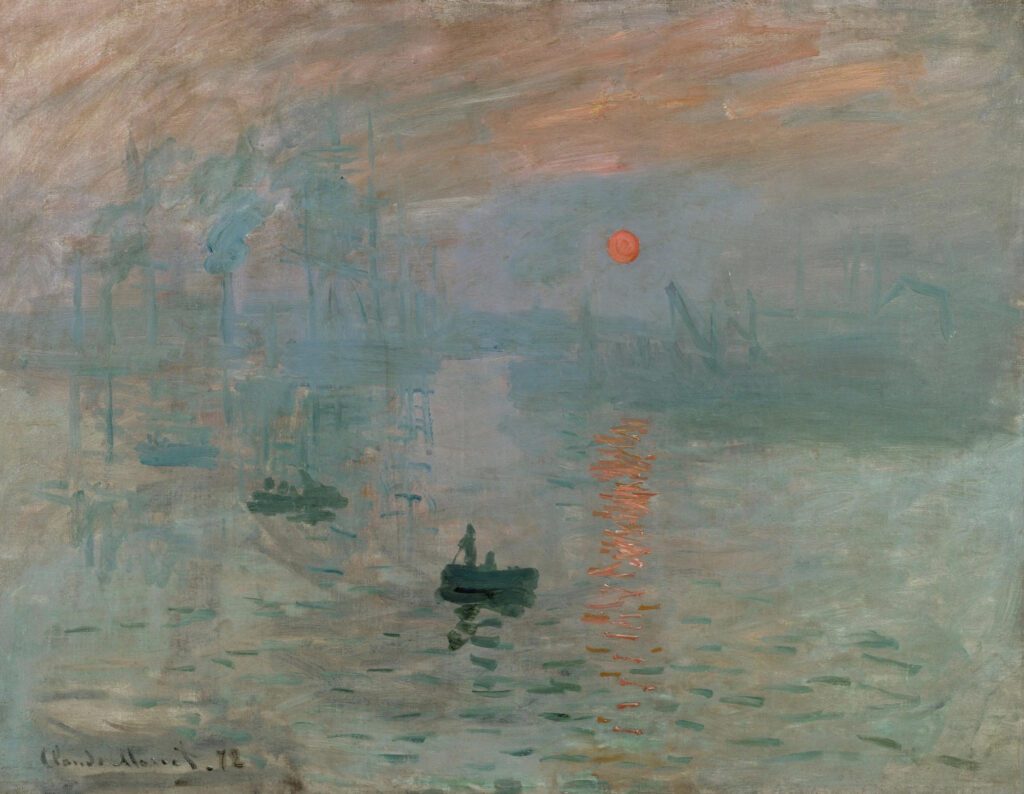
This painting had to be the first on the list for one reason alone. The name of it is what inspired the impressionist movement being named “the impressionist movement.”
This painting portrays Monet’s hometown, Le Havre. Monet was inspired to paint the scene after witnessing a sunrise over the harbor. Also, the hazy atmosphere, the interplay of light and water, and the fleeting nature of the moment captivates him.
Monet employed a limited color palette, primarily shades of blue, orange, and gray, to convey the early morning light. The sun, depicted as a radiant orange orb, is contrasted against the cool tones of the water and sky.
When Monet exhibited the painting at the first Impressionist exhibition in 1874, critics responded disparagingly to its loose, unfinished appearance. One critic, Louis Leroy, used the term “Impressionist” mockingly in a review of the exhibition. He suggested that the artists were more concerned with conveying an impression of a scene rather than creating finished, detailed works.
Today, “Impression, Sunrise” is celebrated as an iconic work of art. It played a crucial role in shaping the trajectory of modern art. It influences subsequent movements such as Post-Impressionism, Fauvism, and even abstraction.
The “Water Lilies” Series (1897-1926)

Claude Monet’s Water Lilies series is one of the most celebrated and iconic bodies of work in the history of art. These paintings exemplify Monet’s fascination with the play of light, color, and reflections on the surface of water. In addition, these paintings were created over several decades. This is among the most famous Monet paintings.
In 1883, Monet moved to Giverny, the small village in Normandy. First, he transformed the property, including a pond, into a Japanese-inspired water garden. To add, the water lilies in the pond became a central motif in his later works. The series continued until his death in 1926. The paintings evolved over time, reflecting changes in his artistic style and experimentation with color and form.
The series includes numerous large-scale paintings, some of which are panoramic in scope. Monet’s decision to work on such a grand scale was unprecedented and added to the series’ impact.
Some of the Water Lilies paintings are monumental in scale. Monet envisioned them as part of an immersive environment. In his later years, he even designed a circular exhibition space to display the paintings in a continuous panorama.
Woman with a Parasol – Madame Monet and Her Son (1875)
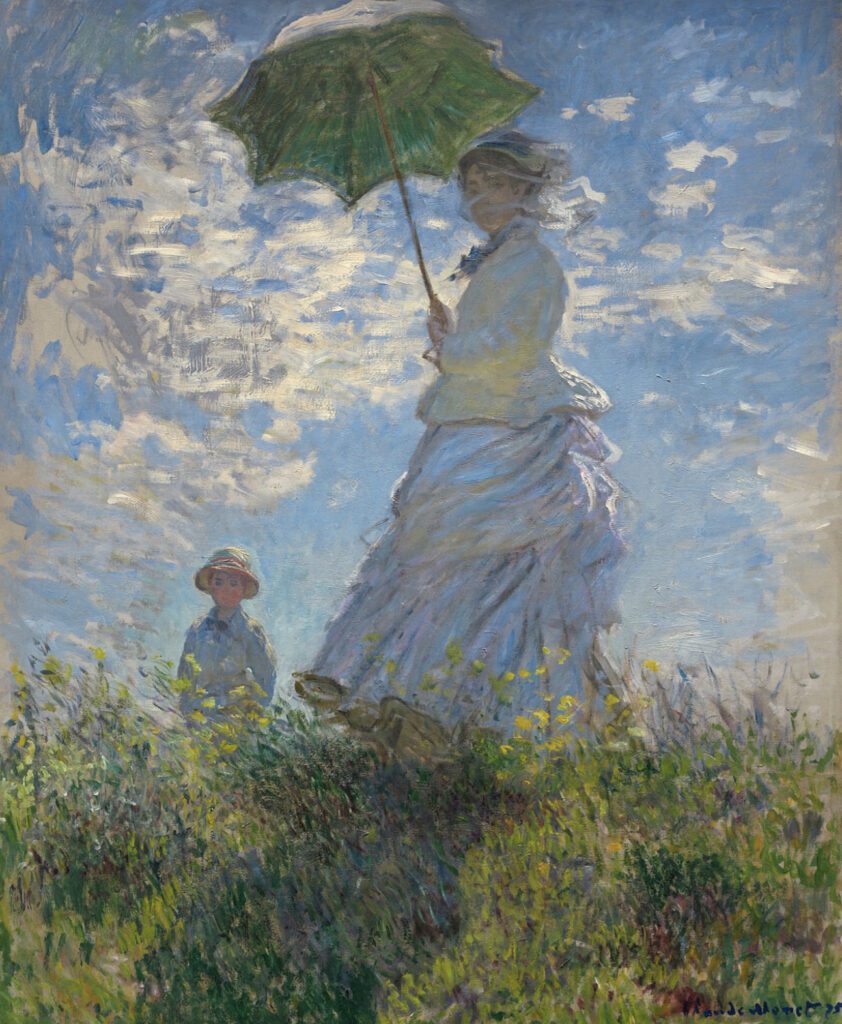
Instead of portraying traditional or staged scenes, Monet captures a spontaneous moment in the life of his wife, Camille, and their son, Jean. The emphasis on capturing ordinary, everyday scenes was a hallmark of the Impressionist movement. This is a personal favorite of mine for the famous Monet paintings.
Like many Impressionist artists, Monet painted “Woman with a Parasol” en plein air. This allowed him to directly observe and capture the effects of natural light on the scene. Also, the influence of Japanese woodblock prints is evident in the composition. There are diagonal lines of the parasol and the figure’s dress resembling the dynamic lines often seen in Japanese art.
The scene is set in the countryside, likely in the area around Argenteuil. This is a suburb of Paris where the Monet family lived for several years. The composition captures a moment of movement, with Camille holding a parasol and walking with her son. Also, Monet conveys a sense of spontaneity and naturalness, avoiding the stiffness of posed portraits.
Not only does this feel more truthful to look on as a memory (without the exact details of figure) but you can feel more with looking at it. To add, most often times with portraits, it feels unbearably less intimate to have it so posed and detail oriented instead of focusing on the feeling.
Haystacks series (1890–1891)

Monet’s “Haystack” series is a testament to his fascination with capturing the effects of light and atmosphere on a single subject. The inspiration for the “Haystacks” series came from the landscape surrounding Monet’s home in Giverny, France. The fields of wheat and haystacks provided a rich and varied subject for his exploration.
Similar to his approach with other series, such as the “Water Lilies” and “Rouen Cathedral,” Monet painted the haystacks repeatedly. Each canvas captured a specific moment, weather condition, or time of day.
Monet painted the haystacks over the course of a year. First, this allows him to capture the seasonal changes in the landscape. Secondly, this approach resulted in a diverse collection of paintings that showcased the haystacks in different contexts.
In the summer, the landscape is often bathed in warm, golden sunlight. Monet captured the haystacks during this season with a vibrant palette of yellows, oranges, and browns. This reflects the intense and direct sunlight.
For another example, Autumn often brings diffused and softer light. This creates a more muted and atmospheric quality in the paintings. Monet’s fall haystacks may exhibit a softer contrast between light and shadow compared to the sharper contrasts of summer.
To see the difference, notice the picture above being from springtime. The picture below is titled “the end of summer”:
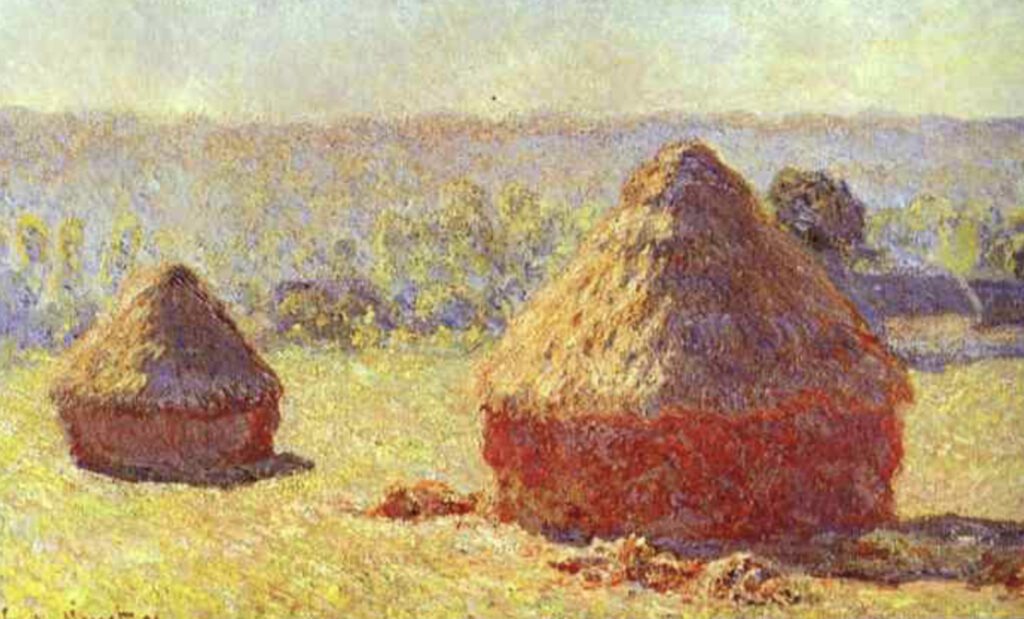
Rouen Cathedral series (1892–1894)
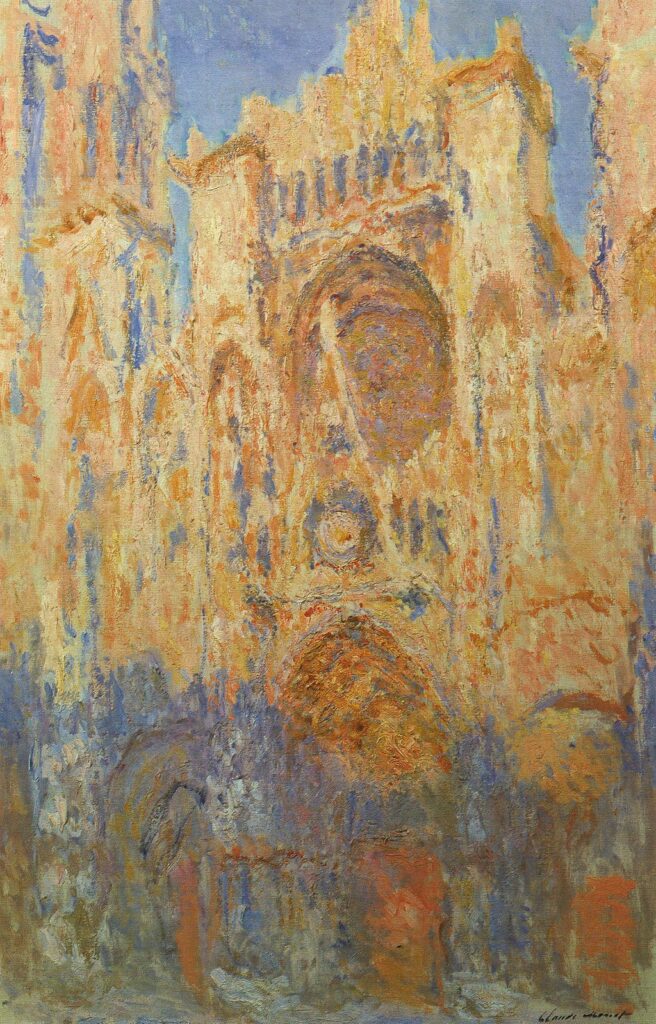
The Rouen Cathedral is a masterpiece of French Gothic architecture. Its construction spans several centuries, with different parts of the cathedral dating from the 12th to the 16th centuries. Also, the cathedral is renowned for its stunning facade, intricate stone carvings, and towering spires.
Monet’s fascination with capturing the effects of light and atmosphere led him to choose the Rouen Cathedral as a subject for a series of paintings. He created more than 30 paintings focusing on the cathedral’s facade, exploring the nuances of light, color, and weather.
One of the most significant things about the paintings of the Cathedral compared to his others is its structure. Haystacks and Water Lilies are every changing and evolving, the cathedral stands the same. This made Monet’s diverse perception of it even the more interesting.
Monet embraced various weather conditions, such as mist, fog, and overcast skies. Each painting reflects a different atmospheric effect, adding diversity to the series. Weather conditions significantly impact the appearance of the cathedral and its surroundings.
The Japanese Footbridge (1920-1922)
Monet’s “Japanese Bridge” series was inspired by the Japanese woodblock prints that he avidly collected. The bridge in his garden at Giverny, which he adorned with wisteria. This became a focal point for this series that continued into his water lilies. The influence of Japanese aesthetics is evident in the curved bridge and the lush vegetation.
The painting captures the bridge in different conditions. This is including the vibrant colors of spring, the lush greenery of summer, and the changing foliage of autumn.
While the “Japanese Footbridge” has its unique characteristics, it shares some thematic elements with Monet’s other series. First, such as the emphasis on the play of light and atmosphere. However, the Japanese Bridge series stands out for its distinct subject matter and the integration of the bridge into the water garden.
Similar to the Water Lilies, you can see the Monet retired to his own peaceful garden in the later years. He had built such a splendid utopia for himself in his backyard that it truly became his muse.
Monet’s garden is divided into two parts:
- Clos Normand:
- The Clos Normand is the flower garden situated near Monet’s house. This part of the garden is characterized by its vibrant flower beds arranged in a formal design. Monet carefully planned the Clos Normand with a variety of flowers, including roses, poppies, tulips, irises, and many others. The flower beds are color-coordinated, creating a visually harmonious and aesthetically pleasing landscape. The Clos Normand reflects Monet’s love for flowers and his meticulous approach to gardening.
- Water Garden:
- The Water Garden is located on the other side of the road that runs in front of Monet’s house. It features a pond with a Japanese bridge covered in wisteria, weeping willows, and water lilies. The water lilies, in particular, became a major subject in Monet’s later paintings, known as the “Water Lilies” series. The Japanese bridge is a distinctive architectural element that adds a touch of exoticism to the garden. The combination of water, plants, and the Japanese bridge creates a serene and picturesque scene.

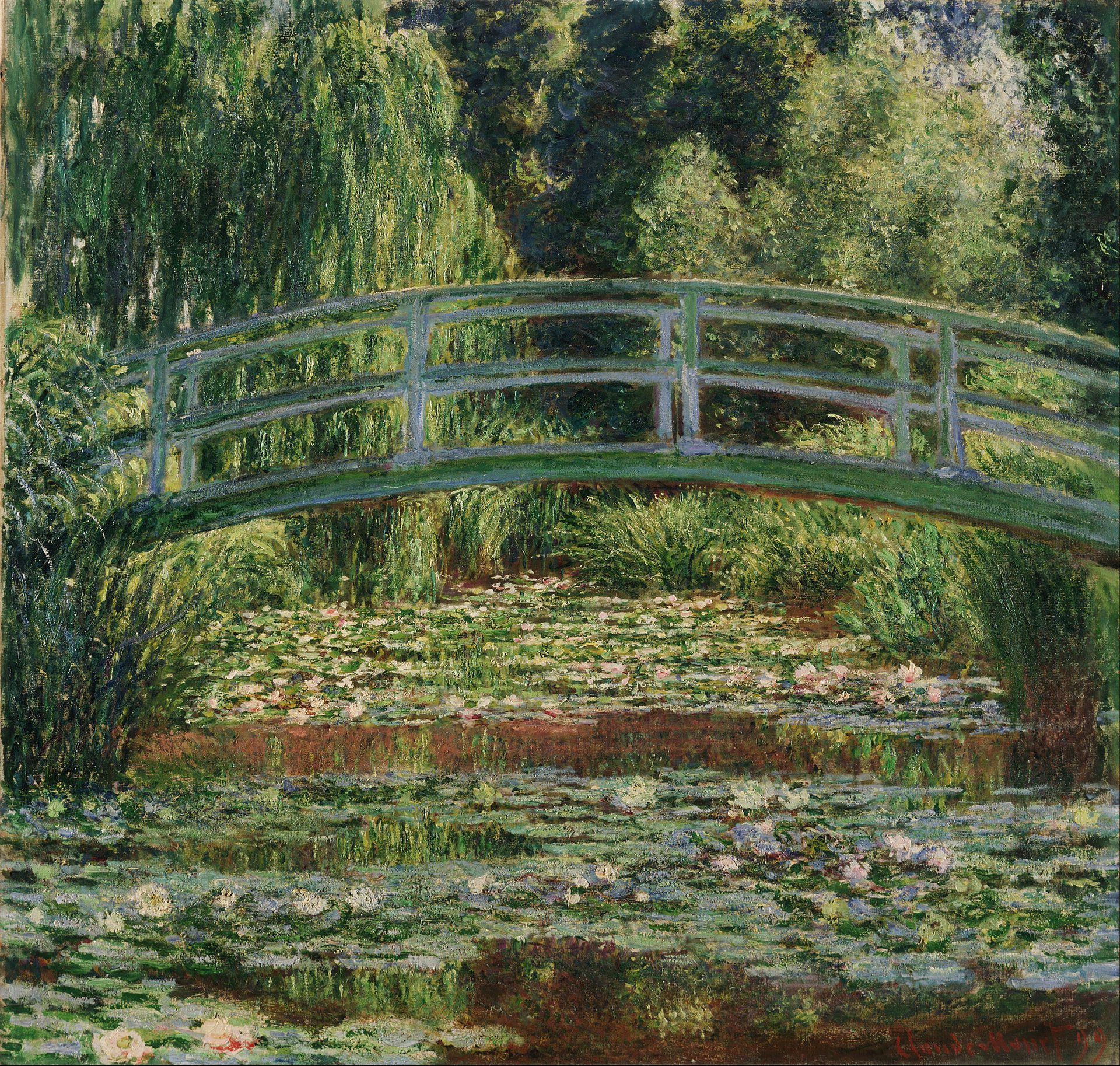
Comments are closed.